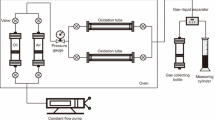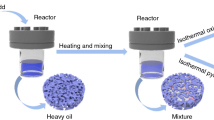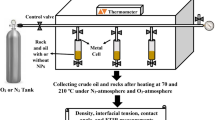Abstract
The heavy metal compounds existing in a reservoir have a significant catalytic effect on the low-temperature oxidation of heavy oil during the in situ combustion (ISC) process. This study focused on the thermal behavior of Tahe ultra-heavy oil and the catalytic effect of copper oxide on low-temperature oxidation to probe into the applicability of the ISC technique. For this purpose, three samples, including Tahe crude oil, oxidized oil and oxidized oil-CuO, were studied by performing thermogravimetry (TG)/derivative thermogravimetry (DTG) and differential scanning calorimetry (DSC) with three different heating rates (5–10 and 15 °C min−1) at temperatures ranging from 30 to 830 °C. The result indicated that more fuel was produced to cause more exothermic heat in the high-temperature oxidation (HTO) zone as the heating rate increased. Kinetic parameter calculation detected that the activation energy of the crude oil was 13.73 kJ mol−1 in the low-temperature oxidation (LTO) stage and 131.72 kJ mol−1 in the HTO stage, respectively. Compared with TG/DSC analysis and the activation energy of the three samples, the activation energy of oxidized oil was reduced obviously in the HTO zone by the crude oil. Additional CuO accelerated fuel deposition in the low-temperature region with no reduction in the activation energy, revealing that CuO has a catalytic effect on Tahe crude oil to cause fuel deposition in LTO. Based on the comprehensive thermal performance and kinetic characterization of the crude oil, 69.61% of the crude oil remained in the final LTO, which can be oxidized as coke to supply sufficient fuel for the HTO stage. This finding indicates that the ISC technique may be feasible for Tahe oilfield development.







Similar content being viewed by others
References
Kozlowski ML, et al.: The catalytic effect of clay on in situ combustion performance. In: SPE Latin American and Caribbean petroleum engineering conference (2015).
Li Y-B, Chen Y, Pu W-F, Gao H, Bai B. Experimental investigation into the oxidative characteristics of Tahe heavy crude oil. Fuel. 2017;209:194–202.
Youtsos MSK, Mastorakos E. Numerical simulation of thermal and reaction waves for in situ combustion in hydrocarbon reservoirs. Fuel. 2013;108:780–92.
Hamedi Shokrlu Y, Maham Y, Tan X, Babadagli T, Gray M. Enhancement of the efficiency of in situ combustion technique for heavy-oil recovery by application of nickel ions. Fuel. 2013;105:397–407.
Karimian M, Schaffie M, Fazaelipoor MH. Determination of activation energy as a function of conversion for the oxidation of heavy and light crude oils in relation to in situ combustion. J Therm Anal Calorim. 2016;125(1):1–11.
Varfolomeev MA, Rakipov IT, Isakov DR, Nurgaliev DK, Kok MV. Characterization and kinetics of Siberian and Tatarstan regions crude oils using differential scanning calorimetry. Pet Sci Technol. 2015;33(8):865–71.
Mothé MG, Mothé CG, Carvalho CHM, Oliveira MCKD. Thermal evaluation of heavy crude oil by simultaneous TG–DSC–FTIR: part 2. J Therm Anal Calorim. 2014;117(3):1357–63.
Kok MV. Thermal behavior and kinetics of crude oils at low heating rates by differential scanning calorimeter. Fuel Process Technol. 2012;96:123–7.
Kök MV, Pokol G, Keskin C, Madarász J, Bagci S. Light crude oil combustion in the presence of limestone matrix. J Therm Anal Calorim. 2004;75(3):781–9.
Kök MV, Karacan Ö, Pamir R. Kinetic analysis of oxidation behavior of crude oil SARA constituents. Energy Fuels. 1998;12:580–8.
Kok MV, Karacan CO. Behavior and effect of SARA fractions of oil during combustion. SPE Reserv Eval Eng. 2000;3(5):380–5.
Bybee K. Heavy oil: combustion-tube experiments show heavy-oil-production increase with addition of catalyst. J Pet Technol. 2008;60:88–90.
Vossoughi S, Bartlett GW, Willhite PG. Prediction of in situ combustion process variables by use of TGA/DSC techniques and the effect of sand-grain specific surface area on the process. Soc Pet Eng J. 1985;25(5):656.
Drici O, Vossoughi S. Study of the surface area effect on crude oil combustion by thermal analysis techniques. J Pet Technol. 1985;37(37):731.
Kok MV, Gundogar AS. Effect of different clay concentrations on crude oil combustion kinetics by thermogravimetry. J Therm Anal Calorim. 2009;99(3):779–83.
Kök MV. Effect of clay on crude oil combustion by thermal analysis techniques. J Therm Anal Calorim. 2006;84(84):361–6.
Li Y-B, Zhao J-Z, Pu W-F, Jia H, Peng H, Zhong D, et al. Catalytic effect analysis of metallic additives on light crude oil by TG and DSC tests. J Therm Anal Calorim. 2012;113(2):579–87.
Li Y-B, Zhao J-Z, Pu W-F, Peng H, Zhong D, Hu Z-W. A method based on the Harcourt and Esson equation to estimate the catalytic effect of metallic additives on light crude oil. J Alloys Compd. 2014;585:7–13.
Li Y-B, Chen Y-F, Pu W-F, Dong H, Gao H, Jin F-Y, et al. Low temperature oxidation characteristics analysis of ultra-heavy oil by thermal methods. J Ind Eng Chem. 2017;48:249–58.
Burger J, Sahuquet B. COMBUSTION « IN SITU » PRINCIPES ET ÉTUDES DE LABORATOIRE. Récupération assistée du pétrole: les méthodes thermiques. 1984;25:117.
Drici O, Vossoughi S. Catalytic effect of heavy metal oxides on crude oil combustion. SPE Reserv Eng. 1987;2(04):591–5.
Velde B. Introduction to clay minerals. J Ferment Bioeng. 1998;86(2):233–5.
Vyazovkin S, Burnham AK, Criado JM, Pérez-Maqueda LA, Popescu C, Sbirrazzuoli N. ICTAC Kinetics Committee recommendations for performing kinetic computations on thermal analysis data. Thermochim Acta. 2011;520(1–2):1–19.
Ren Y, Freitag P, Mahinpey N. A simple kinetic model for coke combustion during an in situ combustion (ISC) process. J Can Pet Technol. 2007;46(4):47–53.
Kök MV, Acar C. Kinetics of crude oil combustion. J Therm Anal Calorim. 2006;83(2):445–9.
Pu W, Pang S, Jia H, Yu D, Liu M, Wang C. Using DSC/TG/DTA techniques to reevaluate the effect of clays on crude oil oxidation kinetics. J Pet Sci Eng. 2015;134:123–30.
Kok MV. Use of thermal equipment to evaluate crude oils. Thermochim Acta. 1993;214(2):315–24.
Kök MV. Influence of reservoir rock composition on the combustion kinetics of crude oil. J Therm Anal Calorim. 2009;97(2):397–401.
Kok MV, Topa E. Thermal characterization and model-free kinetics of biodiesel sample. J Therm Anal Calorim. 2015;122(2):1–7.
Dechelette B, Heugas O, Quenault G, Bothua J, Christensen JR. Air injection-improved determination of the reaction scheme with ramped temperature experiment and numerical simulation. J Can Pet Technol. 2006;45(1):225–30.
Preda V, Văduva I, Mihai I. Low-temperature oxidation of oils in terms of SARA fractions: why simple reaction models don’t work. J Can Pet Technol. 2013;44(3):211–4.
Ren SR, Greaves M, Rathbone RR. Air injection LTO process: an IOR technique for light-oil reservoirs. Soc Pet Eng. 2002;7:90–9.
Coudray C, Fairweathertait SJ. Laboratory studies for light-oil air injection projects: potential application in handil field. SPE Reserv Eval Eng. 2000;3(3):239–48.
Ren SR, Greaves M, Rathbone RR. Oxidation kinetics of north sea light crude oils at reservoir temperature. Chem Eng Res Des. 1999;77(5):385–94.
Zhang L, Deng J, Wang L, Chen Z, Ren S, Hu C, et al. Low-temperature oxidation characteristics and its effect on the critical coking temperature of heavy oils. Energy Fuels. 2015;29(2):538–45.
Freitag NP. Chemical-reaction mechanisms that govern oxidation rates during in situ combustion and high-pressure air injection. SPE Res Eval Eng. 2016;3:713–5.
Ranjbar M, Pusch G. Pyrolysis and combustion kinetics of crude oils, asphaltenes and resins in relation to thermal recovery processes. J Anal Appl Pyrol. 1991;20(20):185–96.
Acknowledgements
The authors wish to recognize financial support from Open Fund (PLN201720) of State Key Laboratory of Oil and Gas Reservoir Geology and Exploitation (Southwest Petroleum University), the National Natural Science Foundation of China (Grant No: 51704245) and 13th Five-Year Plan (2016ZX05053-013). The suppliers of the oil samples and information are also acknowledged. The valuable comments made by the anonymous reviewers are sincerely appreciated.
Author information
Authors and Affiliations
Corresponding authors
Rights and permissions
About this article
Cite this article
Li, YB., Gao, H., Pu, WF. et al. Study of the catalytic effect of copper oxide on the low-temperature oxidation of Tahe ultra-heavy oil. J Therm Anal Calorim 135, 3353–3362 (2019). https://doi.org/10.1007/s10973-018-7577-0
Received:
Accepted:
Published:
Issue Date:
DOI: https://doi.org/10.1007/s10973-018-7577-0




